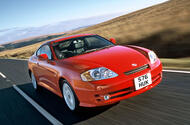Lesser-spotted two-door has baby Ferrari looks and a V6 that sounds the part - it's well worth a look
There are not many Hyundais that you can call classics. The original 1975 Pony, perhaps, simply because it was the company’s first in-house-created car, with help from one Giorgetto Giugiaro (before that, Hyundai made Ford Cortinas), and… well, when you start thinking about it, you’ll struggle.Â
Its early cars were the progeny of a newbie car company experiencing growing pains, most of them low-priced, it’s-all-about-the-deal machines. They gradually got better, of course, but once its cars turned genuinely competitive, few were the kind you’d get nostalgic about unless you fancy the retro irony of the chrome-grilled XG30 saloon or the odd-door weirdness of the Veloster coupé.
There were other coupés, including the low-budget, impressively merit-free S Coupe, this eventually evolving into a car that was worth a second look, possibly a third and maybe even a get-the-cheque-book-out moment.Â
That car was the 2002 Coupe that many scribbling critics, this one included, reckoned looked a little like the Ferrari 456 GT. It kind of still does, partly because of the L-shaped go-faster crease indenting its flanks, partly because it shares much the same proportions.Â
It was also handsome, still is in a quiet way, and unusually for a Hyundai had wheels positioned in the right place relative to its wheel-arch lips. There were no jarring style flourishes, either. The good news continued when you climbed inside. There was plenty of room up front, more than you might expect from the 2+2 rear, a big boot and a dashboard of sculptural and decorative interest. Highlights here included the jutting nozzles of its centre air-vents, the plastiminium decor of a centre console flaunting a trio of dials and a crisply presented instrument array complete with LCD digital readout. Such sophistication.Â
And there was more, the ultimate version powered by a V6 of 163bhp and 182lb ft of torque – sufficient to nail a 0-62mph dash in 8.2sec. Making Hyundai’s most glamorous more affordable were 1.6-litre and 2.0-litre fours.Â
This was a package with far more showroom appeal than any previous Hyundai fastback and, better still, it tackled corners with an aplomb tidy enough to remind you that you were aboard something sporting. The deftness of a Ford Puma wasn’t quite there – the Coupe’s steering was woolier too – but this was a Hyundai that a driver could actually have some fun in, and not for lightly incompetent, XG30-like reasons.Â
Downsides? There were a few. None of the engines, even the V6, provided an especially pleasant aural accompaniment, the style of their power delivery closer to the industrial generator end of the spectrum rather than rortily tuneful race engine. They were thirsty too, 1.6 included, while the V6 could guzzle a gallon in under 20 miles if you were profligate with the throttle.
That wasn’t enough to deter British buyers, however, who turned this Coupe into a minor-league hit. The UK bought more than any country in Europe, and was part-responsible for prolonging the model’s life, Hyundai obliging with an assortment of updates and limited editions. There was a mild refresh five years into its life, mostly cosmetic, and a more substantial upgrade came two years later that saw the faux front wing vents eliminated and the headlights swept rearwards into the front wings. This model was badged SIII.Â
The final TSIII version, conjured especially for the UK, featured quilted leather seats, quad exhausts, stiffer suspension, anthracite alloys and an elevated rear spoiler. This final limited edition followed the Atlantic special edition and a V6 version in yellow that proved a harder sell than ice cream in a blizzard. So it’ll be cheap now, if you can find one.
Like so many coupés, this Hyundai looks like yesterday’s wanted object, largely unwanted today. But it’s a mild tempter as a set of cheap wheels – you need a grand for a smoker, while £3000 gets you the very best – and it’s a car that will, surely, make it to the classic car status that so few Hyundais have achieved in the past.

